Recycled Aggregate Integration for Enhanced Performance of Polymer Concrete
Abstract
1. Introduction
2. Materials and Methods
| Property | LP | 0–2 N | 2–4 N | 4–8 N | 4–8 R |
|---|---|---|---|---|---|
| Density (EN 1097-6 [36]), g/cm3 | 2.71 | 2.54 | 2.64 | 2.67 | 2.53 |
| Density in oven-dry conditions (EN 1097-6 [36]), g/cm3 | - | 2.13 | 2.46 | 2.60 | 2.25 |
| Water absorption (EN 1097-6 [36]), % | - | 7.5 | 2.8 | 1.2 | 4.8 |
| Los Angeles Abrasion (EN 1097-2 [37]), % | - | - | 27.0 | 25.0 | 75.0 |
| Fines percentage (EN 933-1 [38]), % | 100 | 1.0 | 0.1 | 0.1 | 0.9 |
| In Weight | R00 | R10 | R20 | R30 | R40 |
|---|---|---|---|---|---|
| Synthetic vinyl-ester resin, kg | 300 | 300 | 300 | 300 | 300 |
| Limestone powder, kg | 300 | 300 | 300 | 300 | 300 |
| Natural sand (0–2 N), kg | 600 | 600 | 600 | 600 | 600 |
| Gravel (2–4 N), kg | 300 | 300 | 300 | 300 | 300 |
| Gravel (4–8 N), kg | 600 | 450 | 300 | 150 | 0 |
| Recycled aggregate (4–8 R), kg | 0 | 150 | 300 | 450 | 600 |
| RA in total aggregate, % | 0 | 10 | 20 | 30 | 40 |
| Gravel replacement, % | 0 | 25 | 50 | 75 | 100 |
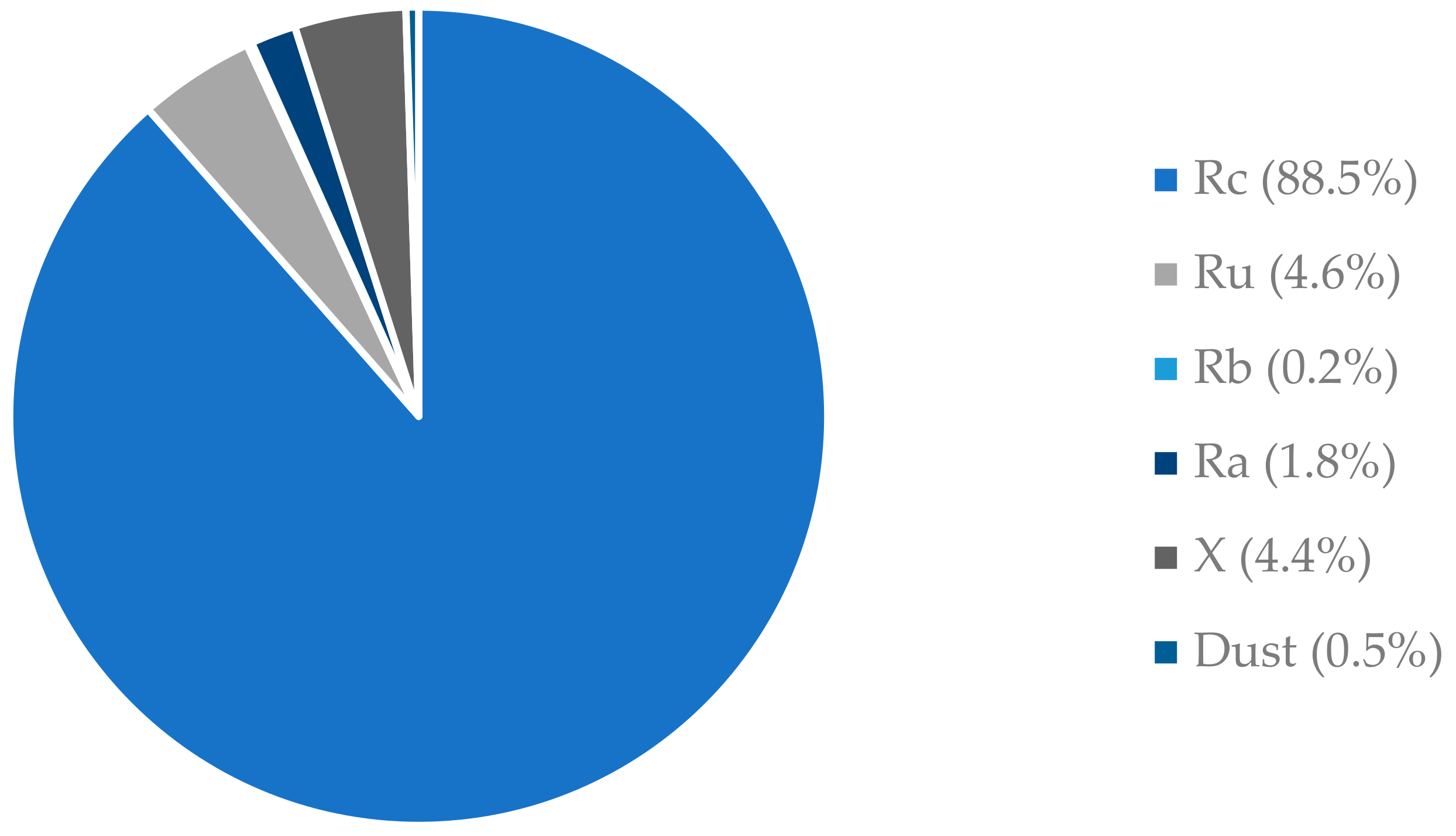
3. Results
4. Discussion and Conclusions
Author Contributions
Funding
Institutional Review Board Statement
Informed Consent Statement
Data Availability Statement
Conflicts of Interest
References
- Blomsma, F.; Brennan, G. The Emergence of Circular Economy: A New Framing Around Prolonging Resource Productivity. J. Ind. Ecol. 2017, 21, 603–614. [Google Scholar] [CrossRef]
- Anwar, M.K.; Shah, S.A.; Alhazmi, H. Recycling and Utilization of Polymers for Road Construction Projects: An Application of the Circular Economy Concept. Polymers 2021, 13, 1330. [Google Scholar] [CrossRef]
- Colangelo, F.; Navarro, T.G.; Farina, I.; Petrillo, A. Comparative LCA of Concrete with Recycled Aggregates: A Circular Economy Mindset in Europe. Int. J. Life Cycle Assess. 2020, 25, 1790–1804. [Google Scholar] [CrossRef]
- Kępniak, M.; Załęgowski, K.; Woyciechowski, P.; Pawłowski, J.; Nurczyński, J. Feasibility of Using Biochar as an Eco-Friendly Microfiller in Polymer Concretes. Polymers 2022, 14, 4701. [Google Scholar] [CrossRef]
- International Solid Waste Association. The Future of the Waste Management Sector. Trends, Opportunities and Challenges for Decade. Available online: https://www.iswa.org/ (accessed on 1 May 2024).
- Nuaklong, P.; Sata, V.; Chindaprasirt, P. Influence of Recycled Aggregate on Fly Ash Geopolymer Concrete Properties. J. Clean. Prod. 2016, 112, 2300–2307. [Google Scholar] [CrossRef]
- Selva Ganesh, M.; Jagadeesh, P. Assessment of Usage of Manufactured Sand and Recycled Aggregate as Sustainable Concrete: A Review. Mater. Today Proc. 2022, 64, 1029–1034. [Google Scholar] [CrossRef]
- Jiang, Y.; Li, B.; Liu, S.; He, J.; Hernandez, A.G. Role of Recycled Concrete Powder as Sand Replacement in the Properties of Cement Mortar. J. Clean. Prod. 2022, 371, 133424. [Google Scholar] [CrossRef]
- Garbacz, A.; Sokołowska, J.J. Concrete-like Polymer Composites with Fly Ashes—Comparative Study. Constr. Build. Mater. 2013, 38, 689–699. [Google Scholar] [CrossRef]
- Barbuta, M.; Bucur, R.D.; Cimpeanu, S.M.; Paraschiv, G.; Bucur, D. Wastes in Building Materials Industry; Pilipavičius, V., Ed.; IntechOpen: Rijeka, Croatia, 2015; Chapter 3. [Google Scholar] [CrossRef]
- Agavriloaie, L.; Oprea, S.; Barbuta, M.; Luca, F. Characterisation of Polymer Concrete with Epoxy Polyurethane Acryl Matrix. Constr. Build. Mater. 2012, 37, 190–196. [Google Scholar] [CrossRef]
- Kaya, A.; Kar, F. Properties of Concrete Containing Waste Expanded Polystyrene and Natural Resin. Constr. Build. Mater. 2016, 105, 572–578. [Google Scholar] [CrossRef]
- Czarnecki, L.; Łukowski, P.; Nejman, R. The Statistical Evaluation of Epoxy Concrete Heterogeneity. Cem. Concr. Compos. 1996, 18, 417–427. [Google Scholar] [CrossRef]
- Ribeiro, M.S.S.; Tavares, C.M.L.; Ferreira, A.J.M. Chemical Resistance of Epoxy and Polyester Polymer Concrete to Acids and Salts. J. Polym. Eng. 2002, 22, 27–44. [Google Scholar] [CrossRef]
- Kȩpniak, M.; Woyciechowski, P.; Franus, W. Chemical and Physical Properties of Limestone Powder as a Potential Microfiller of Polymer Composites. Arch. Civ. Eng. 2017, 63, 67–68. [Google Scholar] [CrossRef]
- Łukowski, P.; Sokołowska, J.; Kępniak, M. The Introductory Evaluation of Possibility of Using Waste Perlite Powder in Building Polymer Composites. Bud. Archit. 2014, 13, 119–126. [Google Scholar] [CrossRef]
- Bulut, H.A.; Şahin, R. A Study on Mechanical Properties of Polymer Concrete Containing Electronic Plastic Waste. Compos. Struct. 2017, 178, 50–62. [Google Scholar] [CrossRef]
- Tonet, K.G.; Gorninski, J.P. Polymer Concrete with Recycled PET: The Influence of the Addition of Industrial Waste on Flammability. Constr. Build. Mater. 2013, 40, 378–389. [Google Scholar] [CrossRef]
- Woyciechowski, P.; Kępniak, M.; Pawłowski, J. Methodology for measuring the carbonation depth of concrete–standard and non-standard aspects. Struct. Environ. 2022, 14, 89–95. [Google Scholar] [CrossRef]
- Tang, B.; Fan, M.; Yang, Z.; Sun, Y.; Yuan, L. A Comparison Study of Aggregate Carbonation and Concrete Carbonation for the Enhancement of Recycled Aggregate Pervious Concrete. Constr. Build. Mater. 2023, 371, 130797. [Google Scholar] [CrossRef]
- Qin, W.; Fan, X.; Jiang, X. CO2-Accelerated Carbonation Modification for Recycled Coarse Aggregate with Various Original Concrete Strengths and Coarse Aggregate Sizes. Materials 2024, 17, 3567. [Google Scholar] [CrossRef]
- Raman, J.V.M.; Ramasamy, V. Various Treatment Techniques Involved to Enhance the Recycled Coarse Aggregate in Concrete: A Review. Mater. Today Proc. 2021, 45, 6356–6363. [Google Scholar] [CrossRef]
- Spaeth, V.; Djerbi Tegguer, A. Improvement of Recycled Concrete Aggregate Properties by Polymer Treatments. Int. J. Sustain. Built Environ. 2013, 2, 143–152. [Google Scholar] [CrossRef]
- Li, L.; Liu, K.; Chen, B.; Wang, R. Effect of Cyclic Curing Conditions on the Tensile Bond Strength between the Polymer Modified Mortar and the Tile. Case Stud. Constr. Mater. 2022, 17, e01531. [Google Scholar] [CrossRef]
- Liu, J.; Ma, K.; Shen, J.; Zhu, J.; Long, G.; Xie, Y.; Liu, B. Influence of Recycled Concrete Aggregate Enhancement Methods on the Change of Microstructure of ITZs in Recycled Aggregate Concrete. Constr. Build. Mater. 2023, 371, 130772. [Google Scholar] [CrossRef]
- Misra, A.K.; Kalra, M.; Bansal, S. Influence of Polymer Treatment on Strength and Water Absorption Capacity of Recycled Aggregate Concrete. Int. J. Sustain. Build. Technol. Urban Dev. 2017, 8, 81–92. [Google Scholar] [CrossRef][Green Version]
- Velardo, P.; Sáez del Bosque, I.F.; Sánchez de Rojas, M.I.; De Belie, N.; Medina, C. Durability of Concrete Bearing Polymer-Treated Mixed Recycled Aggregate. Constr. Build. Mater. 2022, 315, 125781. [Google Scholar] [CrossRef]
- Spaeth, V.; Djerbi Tegguer, A. Polymer Based Treatments Applied on Recycled Concrete Aggregates. Adv. Mater. Res. 2013, 687, 514–519. [Google Scholar] [CrossRef]
- Wang, Y.; Zheng, J.; You, F. Review on Enhancement Methods of Recycled Aggregate. Cailiao Daobao/Mater. Rep. 2021, 35, 5053–5061. [Google Scholar] [CrossRef]
- Mercuri, M.; Vailati, M.; Gregori, A. Lime-Based Mortar Reinforced with Randomly Oriented Polyvinyl-Alcohol (PVA) Fibers for Strengthening Historical Masonry Structures. Dev. Built Environ. 2023, 14, 100152. [Google Scholar] [CrossRef]
- Angiolilli, M.; Gregori, A.; Vailati, M. Lime-Based Mortar Reinforced by Randomly Oriented Short Fibers for the Retrofitting of the Historical Masonry Structure. Materials 2020, 13, 3462. [Google Scholar] [CrossRef]
- Li, L.; Wang, R.; Lu, Q. Influence of Polymer Latex on the Setting Time, Mechanical Properties and Durability of Calcium Sulfoaluminate Cement Mortar. Constr. Build. Mater. 2018, 169, 911–922. [Google Scholar] [CrossRef]
- Polimal. Available online: https://www.polimal.com.pl/ (accessed on 1 May 2024).
- Darimex. Available online: https://www.kopalniadarimex.pl/ (accessed on 1 May 2024).
- EGM. Available online: https://egm.pl/ (accessed on 1 May 2024).
- CEN EN 1097-6; Tests for Mechanical and Physical Properties of Aggregates—Part 6: Determination of Particle Density and Water Absorption. European Committee for Standardization (CEN): Brussels, Belgium, 2022.
- EN 1097-2; Tests for Mechanical and Physical Properties of Aggregates—Part 2: Methods for the Determination of Resistance to Fragmentation. European Committee for Standardization (CEN): Brussels, Belgium, 2020.
- EN 933-1; Methods of Test for Dense Shaped Refractory Products—Part 1: Determination of Bulk Density, Apparent Porosity and True Porosity. European Committee for Standardization (CEN): Brussels, Belgium, 2012.
- CEN-EN 1015-3; Methods of Test for Mortar for Masonry—Part 3: Determination of Consistence of Fresh Mortar (by Flow Table). European Committee for Standardization (CEN): Brussels, Belgium, 1999.
- EN 196-1; Methods of Testing Cement Part 1: Determination of Strength. European Committee for Standardization (CEN): Brussels, Belgium, 2016.
- Nisbet, R.; Elder, J.; Miner, G. Chapter 6—Accessory Tools for Doing Data Mining; Academic Press: Boston, MA, USA, 2009; pp. 99–117. [Google Scholar] [CrossRef]
- Ben Taher, M.A.; Pelay, U.; Russeil, S.; Bougeard, D. A Novel Design to Optimize the Optical Performances of Parabolic Trough Collector Using Taguchi, ANOVA and Grey Relational Analysis Methods. Renew. Energy 2023, 216, 119105. [Google Scholar] [CrossRef]
- Chén, O.Y.; Bodelet, J.S.; Saraiva, R.G.; Phan, H.; Di, J.; Nagels, G.; Schwantje, T.; Cao, H.; Gou, J.; Reinen, J.M.; et al. The Roles, Challenges, and Merits of the p Value. Patterns 2023, 4, 100878. [Google Scholar] [CrossRef] [PubMed]
- Liu, W.; Jia, Y.-X. Comparison of Type I Error and Statistical Power between State Trace Analysis and Analysis of Variance. J. Math. Psychol. 2023, 114, 102767. [Google Scholar] [CrossRef]
- Lesack, K.; Naugler, C. An Open-Source Software Program for Performing Bonferroni and Related Corrections for Multiple Comparisons. J. Pathol. Inform. 2011, 2, 52. [Google Scholar] [CrossRef]
- Chyliński, F.; Michalik, A.; Kozicki, M. Effectiveness of Curing Compounds for Concrete. Materials 2022, 14, 2699. [Google Scholar] [CrossRef]

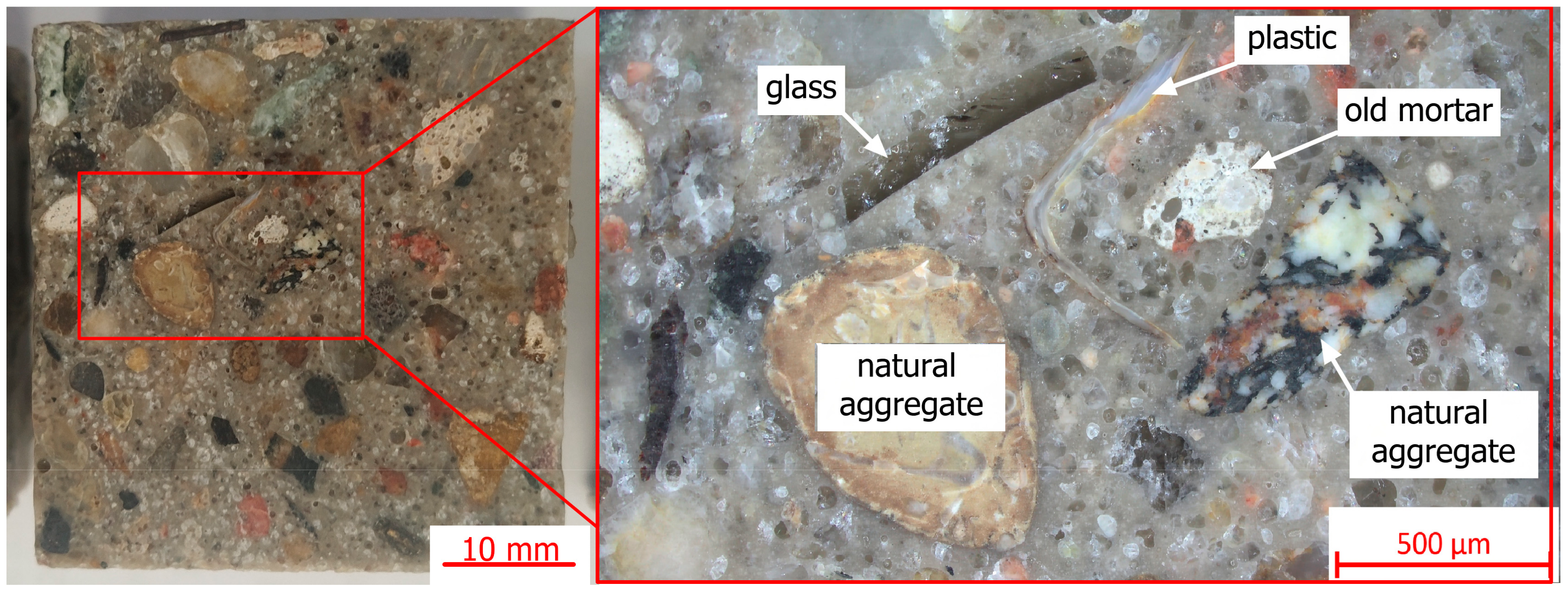
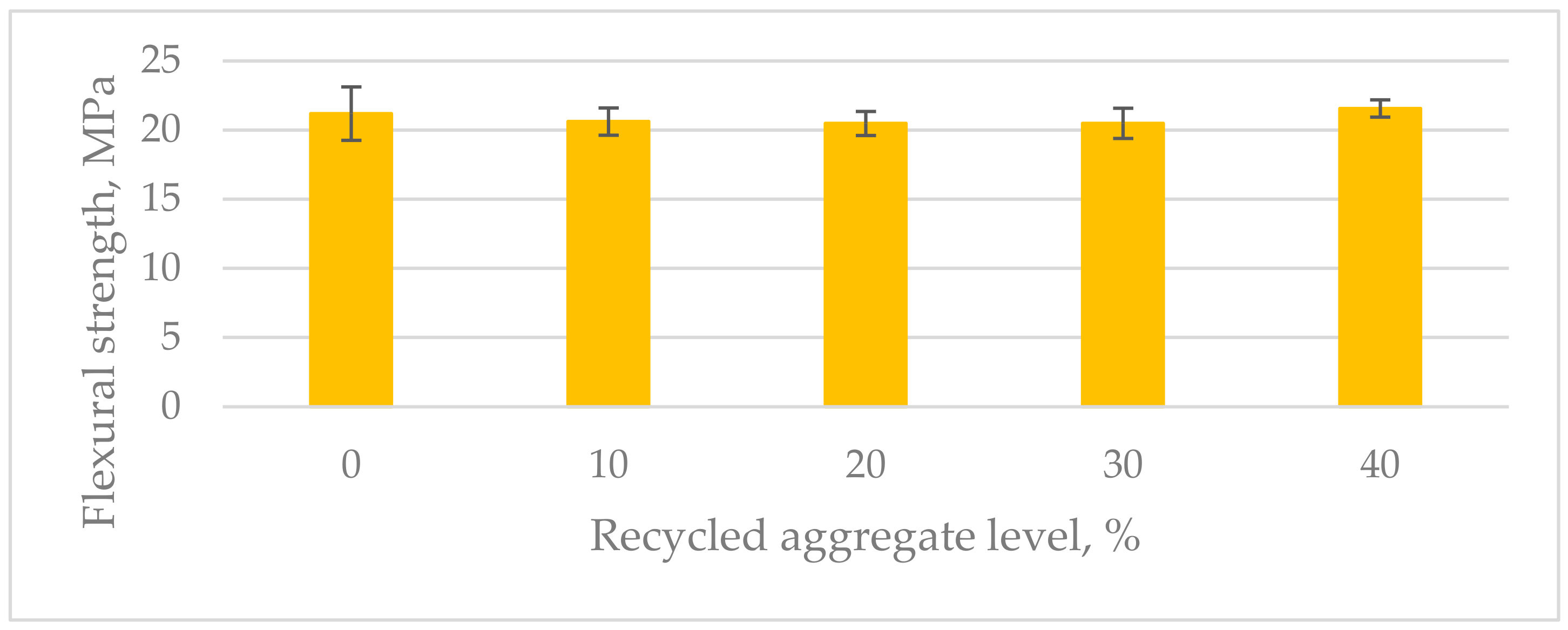
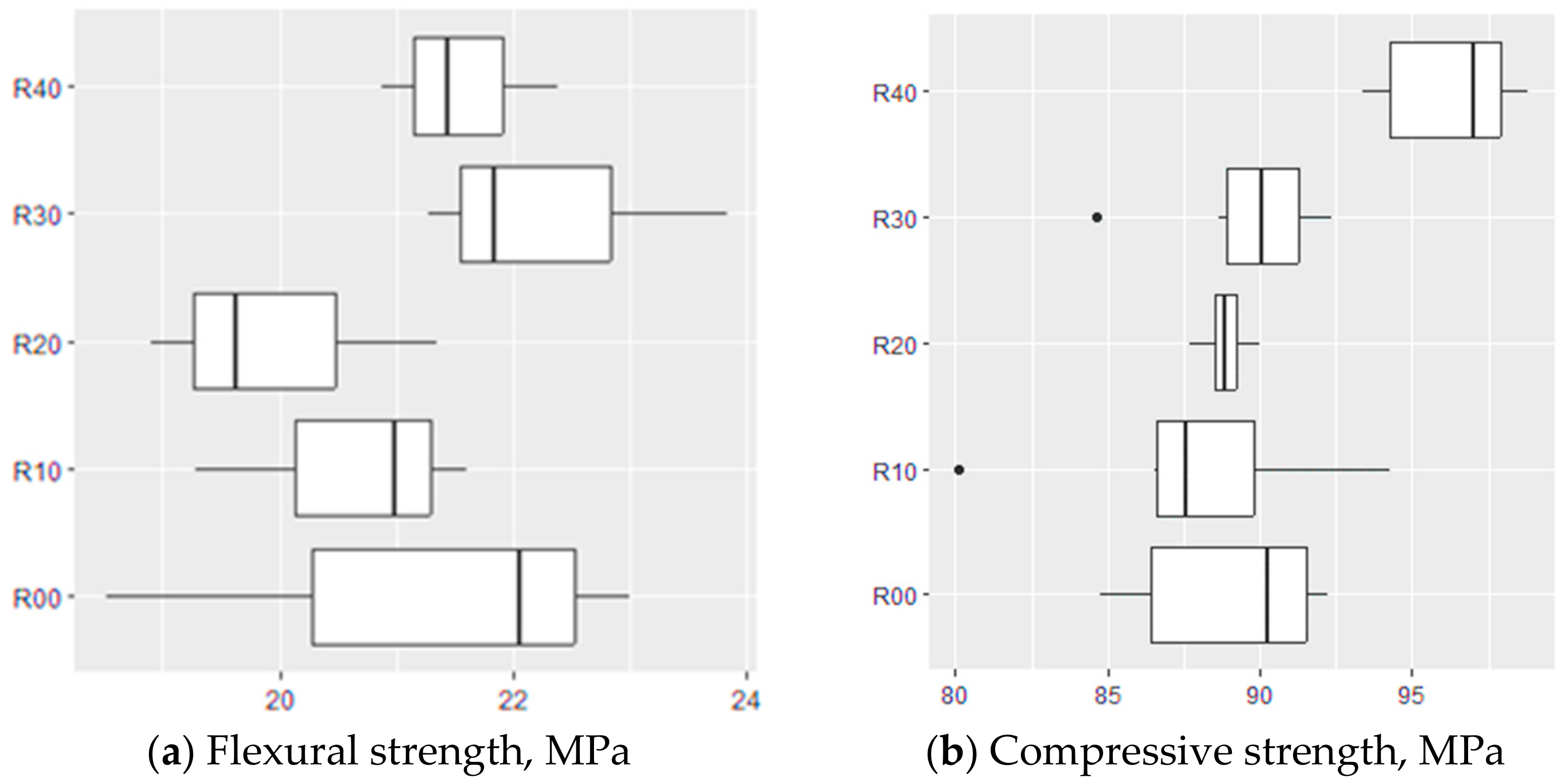

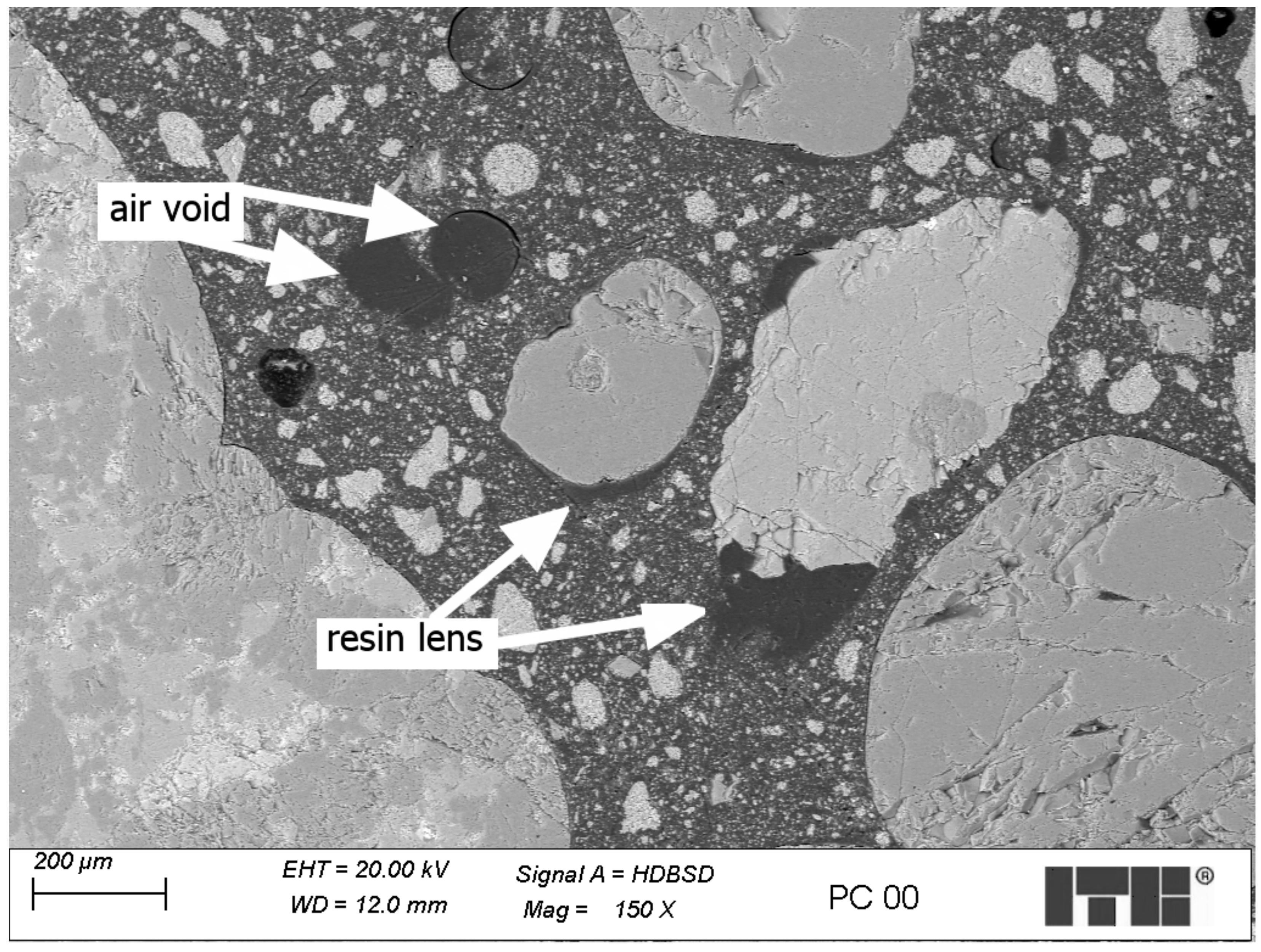
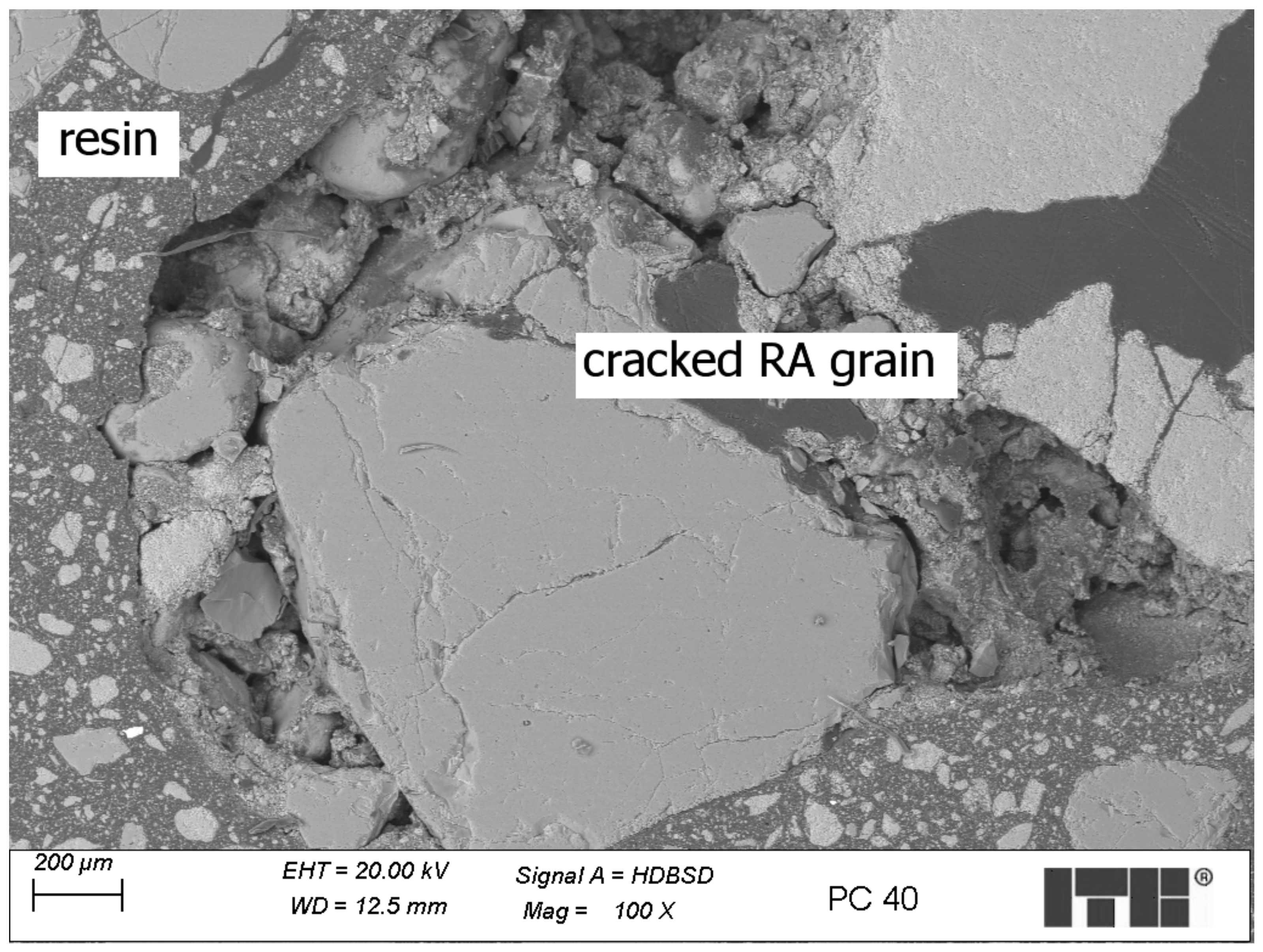

| Composition | Flow, mm | Apparent Density ρ, g/cm3 | Flexural Strength ft, MPa | Compressive Strength fc, MPa |
|---|---|---|---|---|
| R00 | 180 ± 20 | 2.18 ± 0.03 | 21.2 ± 2.4 | 89.1 ± 3.3 |
| R10 | 180 ± 20 | 2.15 ± 0.02 | 20.6 ± 1.2 | 87.7 ± 4.7 |
| R20 | 180 ± 20 | 2.12 ± 0.05 | 20.0 ± 1.3 | 88.9 ± 0.8 |
| R30 | 180 ± 20 | 2.14 ± 0.01 | 22.3 ± 1.3 | 89.6 ± 2.7 |
| R40 | 180 ± 20 | 2.17 ± 0.02 | 21.6 ± 0.8 | 96.3 ± 2.3 |
| Df | Sum Sq | Mean Sq | F Value | Pr(>F) | |
|---|---|---|---|---|---|
| Groups | 4 | 9.653 | 2.4133 | 1.0995 | 0.4085 |
| Residuals | 10 | 21.950 | 2.1949 |
| Df | Sum Sq | Mean Sq | F Value | Pr(>F) | |
|---|---|---|---|---|---|
| Groups | 4 | 279.64 | 69.909 | 7.5803 | 0.0003829 |
| Residuals | 25 | 230.56 | 9.222 |
| R00 | R10 | R20 | R30 | |
|---|---|---|---|---|
| R10 | 1.0000 | - | - | - |
| R20 | 1.0000 | 1.0000 | - | - |
| R30 | 1.0000 | 1.0000 | 1.0000 | - |
| R40 | 0.0038 | 0.0005 | 0.0027 | 0.0073 |
Disclaimer/Publisher’s Note: The statements, opinions and data contained in all publications are solely those of the individual author(s) and contributor(s) and not of MDPI and/or the editor(s). MDPI and/or the editor(s) disclaim responsibility for any injury to people or property resulting from any ideas, methods, instructions or products referred to in the content. |
© 2024 by the authors. Licensee MDPI, Basel, Switzerland. This article is an open access article distributed under the terms and conditions of the Creative Commons Attribution (CC BY) license (https://creativecommons.org/licenses/by/4.0/).
Share and Cite
Kępniak, M.; Chyliński, F.; Łukowski, P.; Woyciechowski, P. Recycled Aggregate Integration for Enhanced Performance of Polymer Concrete. Materials 2024, 17, 4007. https://doi.org/10.3390/ma17164007
Kępniak M, Chyliński F, Łukowski P, Woyciechowski P. Recycled Aggregate Integration for Enhanced Performance of Polymer Concrete. Materials. 2024; 17(16):4007. https://doi.org/10.3390/ma17164007
Chicago/Turabian StyleKępniak, Maja, Filip Chyliński, Paweł Łukowski, and Piotr Woyciechowski. 2024. "Recycled Aggregate Integration for Enhanced Performance of Polymer Concrete" Materials 17, no. 16: 4007. https://doi.org/10.3390/ma17164007
APA StyleKępniak, M., Chyliński, F., Łukowski, P., & Woyciechowski, P. (2024). Recycled Aggregate Integration for Enhanced Performance of Polymer Concrete. Materials, 17(16), 4007. https://doi.org/10.3390/ma17164007








